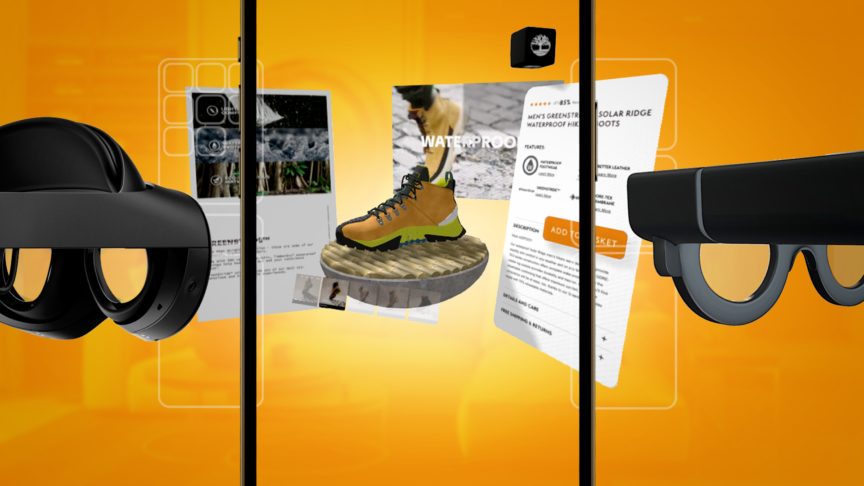Although Augmented Reality (AR) is a less familiar concept than its lookalike Virtual Reality (VR,) it remains one of the top innovations opening up new growth points for businesses around the world.
Unlike VR (which completely replaces reality,) AR provides a composite of both computer-generated images and real-world views. This combo can usually be found in mobile devices as most users already own easily portable AR-capable smartphones.
A great example of the use of this technology is the Pokemon Go app. The combination of AR and real-world geolocation made such perfect sense that the games’ popularity boomed overnight. But is that all augmented reality can offer?
To find the answer to this question, the Cybernews crew sat down with Faisal Galaria, CEO of Blippar – a leading technology company specializing in AR.
Let’s go back to the very beginning. How did the idea of Blippar come about?
Blippar has been pioneering augmented reality creation since 2011. I first came into contact with Blippar in 2012, whilst launching Spotify in the USA. We used Blippar’s technology to provide early access to Spotify via users scanning cans of Coke. I was blown away by the instant, engaging potential of the AR experience. When the opportunity to take the lead at Blippar came up, the timing couldn't have been better; the company was an established leader in the AR space, paving the way for accessible AR creation.
This ethos, combined with the clear market acceleration for AR, notably through the ubiquitous availability of AR-enabled smartphones, AR glasses coming down the pipeline, and the global rollout of 5G telecoms networks, made the transition very enticing.
Can you introduce us to your augmented reality solutions? What are their key features?
Blippar is leading the way for the three-dimensional digital revolution. Our SaaS tools are designed to empower everyone – from bedroom creators with no coding experience to advanced developers and brands – to create, experience, and share AR from anywhere, all accessible directly in the mobile browser with no app download required. We have two creation tools; Blippbuilder and our WebAR SDK.
Blippbuilder is our no-code, self-service, web-based AR creation tool. Its simple drag-and-drop interface allows those with no coding, programming, or production experience to easily create powerful augmented reality experiences.
For the more experienced creative developers, we have our WebAR SDK. Created with developers in mind, this powerful tool allows for the development of next-level engagement, immersion, and innovation that users are seeking across many use cases, including gaming, marketing, entertainment, and education.
In addition to these self-service options, we also have a fully-managed content studio to support enterprise and brand partners in creating and developing AR campaign strategies that achieve real, tangible user engagement and, ultimately, ROI.
In your opinion, which types of organizations would greatly benefit from implementing AR solutions?
The e-commerce industry is ripe for AR disruption, especially in the age of COVID. Imagine buying a ring from Tiffany’s or a jacket from the Banana Republic - if the prospective customer has the option to try these on digitally and assess their purchase in a blended reality environment, then they’re more likely to purchase the items - while also associating your brand with a memorable retail experience. In our experience, brands using AR have higher levels of engagement and can increase conversion by up to 40%.
In order to allow brands to produce AR experiences at scale in today’s all-remote and hybrid work environments, we have integrated our no-code creation tool into Microsoft Teams. Any organization currently working remotely with teams and stakeholders across different cities, countries, and continents will benefit from this solution as the integration allows for collaborative AR creation throughout every stage of the development process.
How did the recent global events affect your field of work? Were there any new features added as a result?
At Blippar, we are doing better than ever before. Not only is the evolution of our SaaS offerings and breadth of partners demonstrative of the quality of our AR platforms, but also how today’s market is becoming more receptive to the possibilities of AR creation and engagement. Recent global events have demonstrated to many brands and enterprises that combining digital and real-world experiences is necessary to engage with and maintain customers.
Over the past few months, we have added Simultaneous Localization and Mapping, or SLAM into our tools. It localizes a device within a space and then maps out of that space. This is done simultaneously via the device’s rear camera, with algorithms continuously analyzing visual data to merge physical and digital realities. For the user, visuals won’t appear floating in mid-air or be interrupted by clipping into real-life objects, making the whole experience more realistic and compelling.
By enabling developers to create richer, more engaging experiences, SLAM is crucial to the future of AR. It is also an integral stepping stone into the levels of immersion that will be needed to create the metaverse – something that has the potential to blend the real world and digital content like never before.
Working with us, technology company Oneplus became the first company to launch a new product using AR. The launch saw the CEO giving a keynote presentation to 620,000 concurrent 3D viewers, with SLAM enabling the AR technology to track motion to ensure the CEO was “anchored” to the user’s actual surroundings. The AR experience transformed the traditional convention center launch model into an impressive multi-media event, with speakers live-streamed onto a futuristic AR stage and users seeing and interacting with the new smartphone.
Where do you hope to see AR technology being used more often in the near future?
Ecommerce, as I mentioned previously, is where I think AR disruption is most necessary, but I’d also add that I believe AR has wide-reaching potential in the “How-to” or “DIY” industries. One of the trends I’ve noticed over the past couple of years has been the growth of Tik Tok as an entertainment leader, nearly supplanting YouTube’s hold on the market. However, the content that has begun dominating YouTube is “How To” and DIY videos. Especially coming out of two years where nobody wanted even service workers in their homes, doing it yourself is back in vogue, and I hope industry leaders can adopt AR.
Imagine, if you will, watching a YouTube video on how to change a spark plug in your particular vehicle and an “AR Option” is provided, allowing you to use a mobile device to actually map your own car’s engine and then visually diagnose and see step-by-step instructions on how to fix the problem, all in your field of view. Or opening a new furniture set that arrived in the mail and being able to visualize product assembly steps and instructions that are mapped perfectly to the space you’re occupying.
Beyond seeing AR being used more in the future, I’m also interested in the advancements in how AR tech is used by creators. With our recent integration of Blippbuilder into Microsoft Teams, we see a major opportunity among our user base to share experiences with one another, integrate AR into existing workflows, and demonstrate the power of AR experiences to organizations using Microsoft Teams.
As we move into the metaverse, what are your predictions and expectations for this new environment?
I believe there’s a fundamental misunderstanding about the metaverse. Even when industry professionals discuss the metaverse, they regularly describe it to me as Fortnite, Roblox, or GTA online - without any real ‘meta’ to it. Too many of us are focused on how we will engage with the metaverse (VR goggles, headsets, desktop, mobile, etc.), and too few are focused on the actual content of the metaverse. Roblox, World of Warcraft, etc., these are all isolated sandboxes, and there’s no way for me to hop out of my WoW account and take my new sword/armor/pet/mount/etc., with me into my next bank heist in GTA Online.
The vision of the metaverse is intended to make the real world a more entertaining and informative place through the melding of physical and digital worlds truly. However, until we can escape the thinking of isolated sandboxes that are viewable through various headsets, the metaverse will remain many distinct miniverses, much like clicking from one website to another today.
What would you consider to be the most important marketing practices companies should follow to increase customer engagement?
The benefits of AR adoption in marketing can’t be understated, but they can be quantified. Brands that are using AR for their customer engagement are seeing significantly heightened engagement times (on average 7 minutes) and a more than 40% increase in conversion rates.
Traditional advertising campaigns accrue audiences, whereas brands and marketers using AR understand the need to turn audiences into engaged participants, and the metrics speak for themselves.
I mentioned previously that I first engaged with Blippar in 2012 when I scanned a QR code on a Coke can and saw something new. If I had to tell marketers one thing, it would be to surprise and delight their consumers and allow their products themselves to become the marketing medium.
In this age of ever-evolving technology, what do you think are the key security practices both businesses and individuals should adopt?
Especially through the lens of the metaverse, there are a lot of concerns that need to be addressed before widespread adoption should even be considered. This would be an all-new digital environment, and I’m concerned with how things including location spoofing or deepfake technology can be used to cause real harm in a digital ecosystem.
Even seemingly small things, like an individual’s digital personal space, can be negatively impacted by bad actors in a metaverse who can invade personal and digital privacy. What stops bad actors in the metaverse from stealing your in-game items, changing your avatar’s outfits to something inappropriate, or getting access to your metaverse password?
Before feeling comfortable traversing the digital wild west, I think we need to address the issues more holistically as an industry.
Would you like to share what’s next for Blippar?
Our key aim for 2022 will be the continued enablement of everyone, from experienced developers to novices with no coding experience, to build immersive, 3D augmented experiences that work on any device (smartphone or HMD) and can be triggered from any social media, website, or app.
To further this aim, Blippar is bringing AR content creation and publishing capabilities to the Microsoft Teams ecosystem by building an app that gives MS Teams users access to the platform and opens up new collaboration opportunities, allowing businesses to further realize and capitalize on the value of AR.
Microsoft Teams users can integrate Blippbuilder directly into their existing workflow, uniting teams, organizations, and stakeholders in their approach and implementation - all within the Teams ecosystem.
Teams’ 270 million monthly active users now can collaborate, experiment, create and share AR projects that work everywhere, quickly and effortlessly. The functionality of adaptive cards, single sign-on, and notifications, alongside real-time feedback and approvals, provides immediate transparency and seamless integration from inception to distribution.


